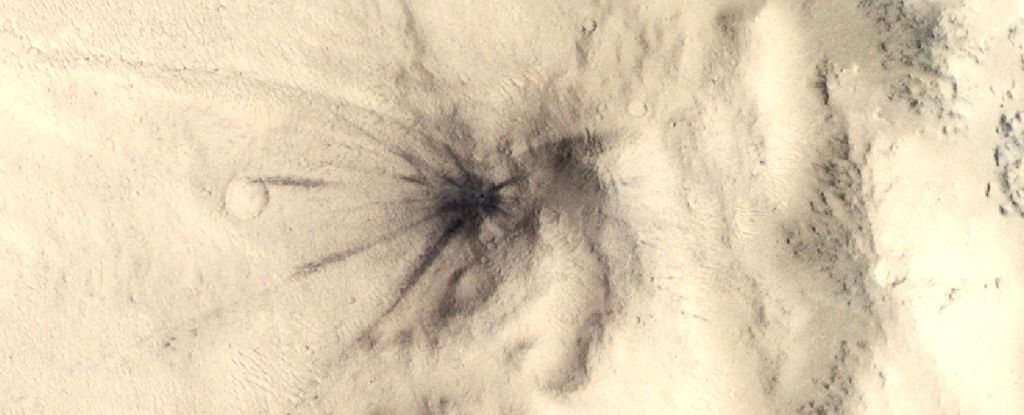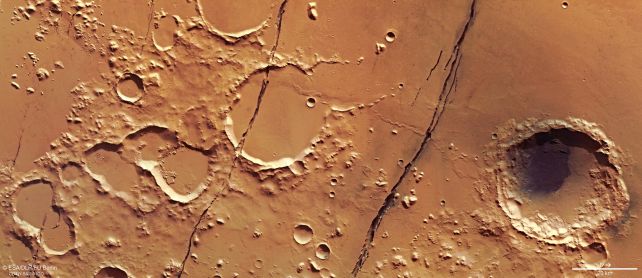
Recent research reveals that the remarkably intense marsquakes shaking the surface of the Red Planet do not always originate from below its crust. Instead, impactful findings suggest that external factors may significantly influence their occurrence.
Using artificial intelligence to scrutinize seismic data, this study highlights the profound shaking and deep roots of these quakes within Mars’ interior. These insights deepen our comprehension of the mysterious Martian core and contribute to our understanding of planetary formation on bodies like Earth, Mars, and Venus.
This research also uncovers that Mars experiences a greater frequency of rock impacts than previously acknowledged, reshaping our understanding of the planet’s subsurface activity.
“Our findings indicate that several recorded marsquakes are the result of meteoroid collisions, not just tectonic movements,” notes planetary scientist Valentin Bickel from the University of Bern, Switzerland.
“This discovery significantly affects our calculations regarding the occurrence of marsquakes and enhances our grasp of the Martian surface’s dynamics overall.”

Despite being the second-most studied planet in our Solar System, following Earth, there’s still a vast amount we remain unaware of regarding Mars’ dynamics, history, and development. Our current data is limited to what can be gleaned from afar, necessitating the deployment of robotic instruments millions of kilometers across space to transmit findings back to Earth.
One notable instrument was the Mars InSight lander, which operated from 2018 to 2022 as a seismic monitoring station, designed to detect movements beneath Mars’ surface. Many scientists presumed that Mars was nearly geologically inert, making it all the more surprising when InSight recorded over 1,300 quakes during its operational period.
Seismic activity on Mars can stem from either internal geological or magmatic processes or from the impacts of incoming space debris. Researchers have even managed to connect the tremors detected by InSight to newly formed craters.
Bickel and his team implemented a machine learning algorithm to identify newly formed impact craters during the operational period of InSight. They analyzed surface images collected by the HiRISE instrument on the Mars Reconnaissance Orbiter.

They subsequently matched the 123 new craters with the seismic recordings from InSight, successfully correlating 49 seismic events with at least one impact event.
“Our findings indicate that impacts on Mars occur more frequently than previously established through earlier studies utilizing orbital imagery,” states Bickel.
According to the new estimates, the rate of significant impacts on Mars is now believed to be 1.6 to 2.5 times higher than earlier projections, indicating that the planet, with its thin atmosphere, is subject to considerable bombardment.
In a related study, the researchers focused on an impact site—a 21.5-meter (70.5-foot) crater located near Cerberus Fossae, a volcanic region known for its seismic activity. They successfully connected this crater to a high-frequency marsquake, suggesting that previous interpretations of the region may need adjustment.
“Our earlier assumptions were that Cerberus Fossae solely produced high-frequency signals due to internal quakes, but this finding indicates that some of that activity could indeed be linked to impacts,” explains planetary scientist Constantinos Charalambous from Imperial College London.

The research team also analyzed InSight’s quake data to gain a deeper understanding of how impacts influence Mars. Their findings revealed that seismic waves generated by impacts were not limited to the planet’s crust but could travel deeper into the mantle through what they termed a ‘seismic highway,’ reaching more remote areas of Mars.
This calls for a reevaluation of previous assumptions. The transmission of seismic waves can reveal various material densities along their path, and misunderstandings in this area may have led to an inaccurate representation of Mars’ internal structure.
“These revelations challenge prior beliefs about how seismic waves propagate and imply that many recorded marsquakes originated at greater distances from the InSight lander than we previously thought,” Charalambous adds.
“Besides recalibrating the locations of several quakes, this also necessitates a reassessment of Mars’ internal structural model.”
The findings from these two studies have been published in Geophysical Research Letters, accessible here and here.









